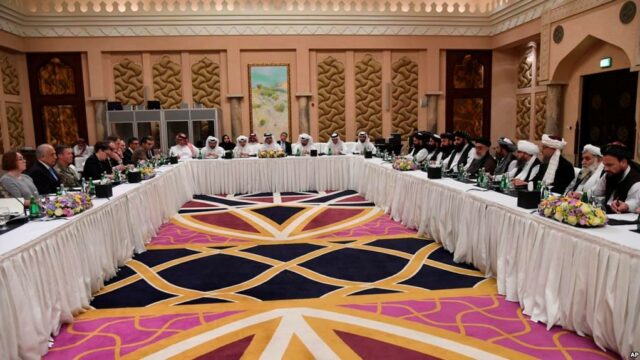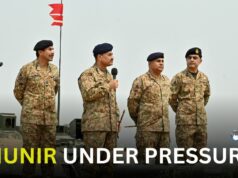NEW DELHI: As U.S. troops marched into Kabul alongside the rag-tag militia of the Northern Alliance in 2001 and the Taliban melted away into the countryside, Afghan émigrés from across the world came flooding back into the city. Kabul Inter-Continental hotel was a hive of activity; the well-heeled, foreign-educated Afghan rubbing shoulders with powerful warlords and their side-kicks, all vying for public office after years of Taliban’s oppressive, misogynistic rule.
One of the high-profile residents of the hotel on the hill to whom everyone gravitated towards in those heady days filled with hope of a better future was Zalmay Khalilzad. Well before his formal appointment as the U.S. ambassador to Afghanistan two years later, the Afghan-born, U.S. educated diplomat always had a great sense of his place in history.
Nineteen years on, this February, everything that ‘Zal’ Khalilzad believed he had worked for—an Afghanistan ruled by moderate Afghans—seemed to have come to fruition. Or had it?
For a giddy 24 hours last Saturday, it looked as if he had pulled off a deal to finally hold off the enemy that had preyed on NATO and ISAF-backed Afghan forces with impunity. But the Taliban’s new political chief Mullah Abdul Ghani Baradar didn’t even wait for the ink to dry on this ‘peace’ deal with the non-existent Islamic Emirate of Afghanistan—the name of the Taliban state when they held Kabul from 1996 to 2001. It was back to business as usual with Taliban forces on the rampage, first in Kunduz and then Helmand.
It smacked of the first U.S. president, former President Barack Obama, openly declaring a troop withdrawal in December 2009, only to find they couldn’t.
Is this where Trump is headed? Making an announcement that will win him plaudits at home but will be impossible to keep?
With Khalilzad playing to the aspirations of only two of three stakeholders—the United States, whose president wants a quick exit of troops as a boost to his electoral campaign; the Taliban, who just want an emirate; the Afghan political leadership left rudderless—it’s a deal that is more optics than reality.
Khalilzad and Donald Trump may want to avoid a repeat of the last time a superpower exited this ‘graveyard of empires’, as in 1988-1989, when the Soviets became sitting targets for the U.S.-armed mujahideen. U.S. troops cannot become a target of the Taliban and its affiliate the Haqqani network who have especially close ties with Pakistan’s Inter Services Intelligence. The relationship dates back to the time the Haqqanis evacuated hundreds of ISI operatives from Kunduz to safety, as the U.S. invaded in 2001. Today, they operate with impunity from sanctuaries inside Pakistan and Afghanistan.
In a sign of their continuing influence, Sirajuddin Haqqani (son of the founder, Jalaluddin Haqqani, with the other son Anas, vocal and visible at the Doha talks) authored a piece in the New York Times last week, where he talked up the peace talks. Second in command in the Taliban today and a known ISI hand, he reportedly lives in Peshawar under the ISI’s protection. Was the aim of the op-ed to lull ordinary Americans into the false premise that the Talibs were sincere about wanting peace? How false that supposition is became evident when within 48 hours of the deal, the Taliban had unleashed its firepower on Afghan and U.S. army bases across the country. And the U.S. military hit back.
The U.S. military, unlike the White House, is under no illusion over the Taliban’s intent. As Gen. Mark Milley, the chairman of the U.S. Joints Chief of Staff said on Monday: “I would caution everybody to think that there’s going to be an absolute cessation of violence in Afghanistan. That is probably not going to happen.”
The Taliban’s time-worn strategy of keeping up the pressure on the battlefield to extract more concessions in the next round of negotiations has been all too clear. If U.S. and foreign forces do begin to exit over the next 14 months as laid down in the deal, reducing numbers from an already pared down 14,000 to 8,600 across five army bases, Afghan forces will be vulnerable, given that the last buffer between them and the Taliban will be gone.
The bigger flaw is that the key third party, the incoming elected government of President Ashraf Ghani, already on the back foot over questions of its electoral legitimacy from main rival Abdullah Abdullah, is chafing at being pushed into doing business with an enemy no one fully trusts. The agreement directs the Ghani dispensation to empower a negotiating team to sit across the table with the Talibs in Oslo on March 10 in an intra-Afghan dialogue that aims to arrive at a permanent cease-fire and a power-sharing agreement between the rival Afghan groups.
Ghani did sign a joint declaration with U.S. Defense Secretary Mark Esper and NATO Secretary General Jens Stoltenberg, which pins him down to holding negotiations with the Taliban and gives Afghanistan a security cover during the process. In rejecting the main point of the agreement, the handover of over 5,000 Taliban prisoners kept at Bagram air base in return for 1,000 men being held by the Taliban, Ghani could be flexing his muscles. A negotiating tactic, he may be making it difficult for the U.S to replace him with another Pashtun. With reports indicating that the paperwork to release the Taliban has already begun at Bagram, Ghani’s tenuous position is obvious. He needs the backing of the U.S. to stay on. At the same time, he cannot be seen as the foreign ‘stooge’ that the Taliban accuses him, and indeed, the entire political leadership, of being.
Caught in the middle is the ordinary Afghan, paying the price for this ethnically driven fratricide, rooted in tribal rivalry that pits the majority Pashtun on the one side against the Tajik, Uzbek and the Hazara minorities.
The buzz is that a Pashtun replacement for Ghani could be either former president Hamid Karzai, or Omar Zakhliwal, the current ambassador to Pakistan, who worked with the U.S. and Pakistan to bring about the release of Taliban leader Mullah Baradar, from a Pakistan jail so that he could front the talks with Khalilzad.
Baradar, incidentally, was released from a Pakistan jail last year after being incarcerated for over eight years. But the manner of his sudden arrest in Karachi just as he had reached out to the Karzai government has always given rise to speculation that his descent into a drug-addled zombie while in jail, was to ensure that he would not go against Pakistan’s plans to scuttle Taliban-Afghan peace overtures.
Baradar was one of the few in the top rungs of the Taliban who had repeatedly called for peace talks with the Hamid Karzai government. Said to be Mullah Omar’s brother-in-law, and whom he reportedly drove to safety as U.S. troops came in, he is also said to have saved Karzai when Jalaluddin Haqqani hunted down and killed the one-legged Commander Abdul Haq, with whom Karzai was putting together an anti-Talib force in 2001. In fact, Pakistan’s release of Baradar raises the big question on where Pakistan’s ISI which has long played puppeteer to the Taliban will stand post the inevitable return of hostilities on the ground. And where that will leave India, whose investments to the tune of $3 billion apart and the enormous goodwill it enjoys as a home to thousands of Afghan students, could all be in jeopardy.
The leader of the India-friendly Northern Alliance, Abdullah Abdullah, a target of the Taliban has been a trenchant critic of Pakistan’s active backing of Taliban sanctuaries in North Waziristan that kept the Afghan government’s writ limited to Kabul and the north. There are conflicting reports on the Panjsheri leader being actively wooed by Islamabad, with other insiders saying his grand coalition that draws in Uzbek strongman Abdul Rashid Dostum, former Balkh governor Ata Mohammed Noor, Hazara chief Mohammed Mohaqiq and even Ismail Khan of Herat could see a possible vivisection of the country, that is already effective on the ground.
Adding to the confusion is where that leaves the ambitious Amrullah Saleh, the former intelligence chief in the Karzai government, the chief point of contact between the U.S. and Kabul, for years, and opposed to any overtures to the Taliban that Khalilzad, during his tenure as three time ambassador, repeatedly attempted.
The assassination of former President Burhanuddin Rabbani by the Haqqani network, which operates as an arm of Pakistan’s counter-intelligence unit, was only one of many outreaches that would go awry. Saleh, who contested on President Ashraf Ghani ticket as his vice president, wrote in a recent piece in the New York Times, hours before Khalilzad would close the deal with the Taliban in Doha, of how, despite he and his hapless family including his sister being a target, he was now willing to give the Taliban a chance. Saleh, was once a close aide to Northern Alliance chief Ahmed Shah Massoud, who was eliminated, only days before 9/11, by Osama bin Laden’s Al Qaida, which at the time had been given protection by the Taliban leader Mullah Omar, even after 9/11.
For the Taliban—and their ISI mentors across the border—the deal is exactly what they had hoped for, bringing about a withdrawal of all foreign forces, opening the door to retaking of Kunduz, Kandahar and Kabul, when the time is right.
The presence of the Pakistan foreign minister Shah Mahmood Qureshi at the Doha venue and his statement thereafter that talks between Pakistan and Afghanistan cannot be mandated by the peace deal is a tell, if needed, that Pakistan has the upper hand and will not be dictated to. Without Pakistani goodwill, the U.S. cannot execute a safe and secure troop withdrawal. That the Taliban have not signed off on to a promise not to provide safe havens to terrorists, denounce terrorism and sever links with Al Qaida and ISIS raises the question on who will police the deal.
The Indian envoy from Qatar’s attendance at the Doha signing, preceded by the visit to Kabul by new foreign secretary Harsh Shringla, and the statements by the Minister of External Affairs S. Jaishankar on adopting a wait and see approach, raise eyebrows on what possible gains could come India’s way, if it means a return of the Taliban. Delhi’s much vaunted push for Afghan products to get market access to India through the Zaranj-Dalaram highway that it built, and to Central Asia through the Iranian port of Chabahar that it hopes to have access to, and through direct flights from Afghan airports, will require a friendly government in Kabul. Given the Taliban’s past propagation of conservative Islam, even India’s soft power through its freewheeling music and Bollywood movies will be severely constrained, in a Kabul where young people of all sexes have thronged its theatres, and profusion of eateries.
Independent analysts like Sumeer Bhasin, says that its time India stops looking at Afghanistan through a Pakistan prism, pointing out that the Taliban have never expressed any interest in taking their subversive movement into Indian territory. Although, it must be said both the Mumbai attack and Kashmir terror infiltration have the imprimatur of the Lashkar-e-Toiba and its offshoots which were born, nurtured and trained in the crucial years when the Taliban allowed Al Qaida to flourish. Bhasin believes that there is a moderate element in the Taliban which wants India to grow into the role of a strategic influencer and counterbalance the hold of Pakistan over its rank and file. There is little proof of that. But with the world watching, Pakistan may no longer be able to provide safe sanctuaries to terror groups like the Haqqani network that are avowedly anti-Indian.
As the U.S. wrestles with the fallout of its military’s domination of foreign policy and the counter-narrative provided by strategic thinkers like Khalilzad who seek to extricate it from Afghanistan, it must know a hasty and ill-considered exit will leave largely lawless Afghanistan open to a complete meltdown.
Simply put, the Doha deal, must be revisited.
(Neena Gopal is a journalist and author. Views expressed in this article are personal.)





